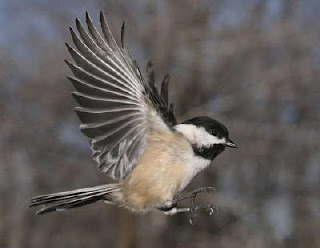The most widespread, numerous, and geographically variable chickadee, this bird brightens winter days at bird feeders and eagerly takes advantage of nest boxes. It is curious, with little or no fear of humans, and it is famous for willingly, after a little “training,” taking seeds and nuts from the hand. During fall postbreeding movements, its noisy little parties usually contain titmice, nuthatches, woodpeckers, and other species. The calls of a flock of black-cappeds in the fall often signal the presence of migrant warblers and vireos. Polytypic. Length 5.3" (13 cm).
Identification Black cap; white cheek; black bib; gray upperparts; greater coverts, secondaries, and tertials edged conspicuously white in fall and winter (less distinct in summer when the white fringes are worn off); sides and flanks buffy or pinkish when fresh, fading to pale buff by summer when worn; outer tail feathers edged prominently white.
Geographic Variation Three subspecies groups differ in several characters. A “northwestern” group is small and dark-backed, with narrow white wing edgings, and flanks heavily washed buffy tan. An “interior western” group is large and pale-backed, with broad white wing edgings, and pale buffy sides and flanks. An “eastern” group is variable, but its subspecies are generally intermediate between the other 2 groups in size, darkness of back, prominence of white wing edgings, and richness of buff wash on the flanks.
Similar Species Although the mountain chickadee is the black-capped’s closest relative, the Carolina chickadee likely will cause the most trouble, especially in late spring and summer when the black-capped’s white wing edgings are worn. Where their ranges overlap, the 2 species resemble each other and they also hybridize, intergrading characters. Otherwise, the combination of bright white cheek, especially in fresh plumage, pure black cap and bib, gray upperparts, bright wing edgings, and pinkish sides and flanks should distinguish the black-capped from other species.
Voice Call: chick-a-dee-dee-dee, lower and slower than Carolina. Song: a clear, whistled 2-noted fee-bee or 3-noted fee-bee-ee, the first note higher in pitch. In the Pacific Northwest some birds sing fee-fee-fee with no change in pitch.
Status and Distribution Common. Year-round: deciduous and mixed woodlands, clearings, suburbs, and urban parks. Occurs in the Appalachians at higher elevations than the Carolina. Fall & winter: makes irregular irruptions south, usually not far into the Carolina’s range, but casually to southeastern Missouri, eastern Kentucky, eastern Virginia, Maryland, more exceptionally as far south as Arizona, Oklahoma, and Texas.
Population Stable or increasing in nearly all regions, though its range may be contracting in areas where the Carolina is expanding.
—From the National Geographic book Complete Birds of North America, 2006
Identification Black cap; white cheek; black bib; gray upperparts; greater coverts, secondaries, and tertials edged conspicuously white in fall and winter (less distinct in summer when the white fringes are worn off); sides and flanks buffy or pinkish when fresh, fading to pale buff by summer when worn; outer tail feathers edged prominently white.
Geographic Variation Three subspecies groups differ in several characters. A “northwestern” group is small and dark-backed, with narrow white wing edgings, and flanks heavily washed buffy tan. An “interior western” group is large and pale-backed, with broad white wing edgings, and pale buffy sides and flanks. An “eastern” group is variable, but its subspecies are generally intermediate between the other 2 groups in size, darkness of back, prominence of white wing edgings, and richness of buff wash on the flanks.
Similar Species Although the mountain chickadee is the black-capped’s closest relative, the Carolina chickadee likely will cause the most trouble, especially in late spring and summer when the black-capped’s white wing edgings are worn. Where their ranges overlap, the 2 species resemble each other and they also hybridize, intergrading characters. Otherwise, the combination of bright white cheek, especially in fresh plumage, pure black cap and bib, gray upperparts, bright wing edgings, and pinkish sides and flanks should distinguish the black-capped from other species.
Voice Call: chick-a-dee-dee-dee, lower and slower than Carolina. Song: a clear, whistled 2-noted fee-bee or 3-noted fee-bee-ee, the first note higher in pitch. In the Pacific Northwest some birds sing fee-fee-fee with no change in pitch.
Status and Distribution Common. Year-round: deciduous and mixed woodlands, clearings, suburbs, and urban parks. Occurs in the Appalachians at higher elevations than the Carolina. Fall & winter: makes irregular irruptions south, usually not far into the Carolina’s range, but casually to southeastern Missouri, eastern Kentucky, eastern Virginia, Maryland, more exceptionally as far south as Arizona, Oklahoma, and Texas.
Population Stable or increasing in nearly all regions, though its range may be contracting in areas where the Carolina is expanding.
—From the National Geographic book Complete Birds of North America, 2006


